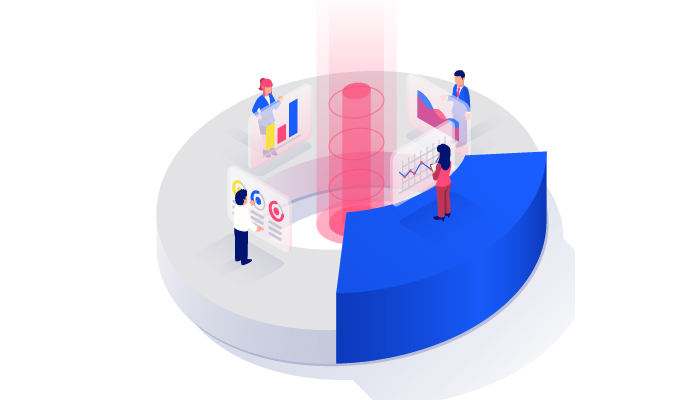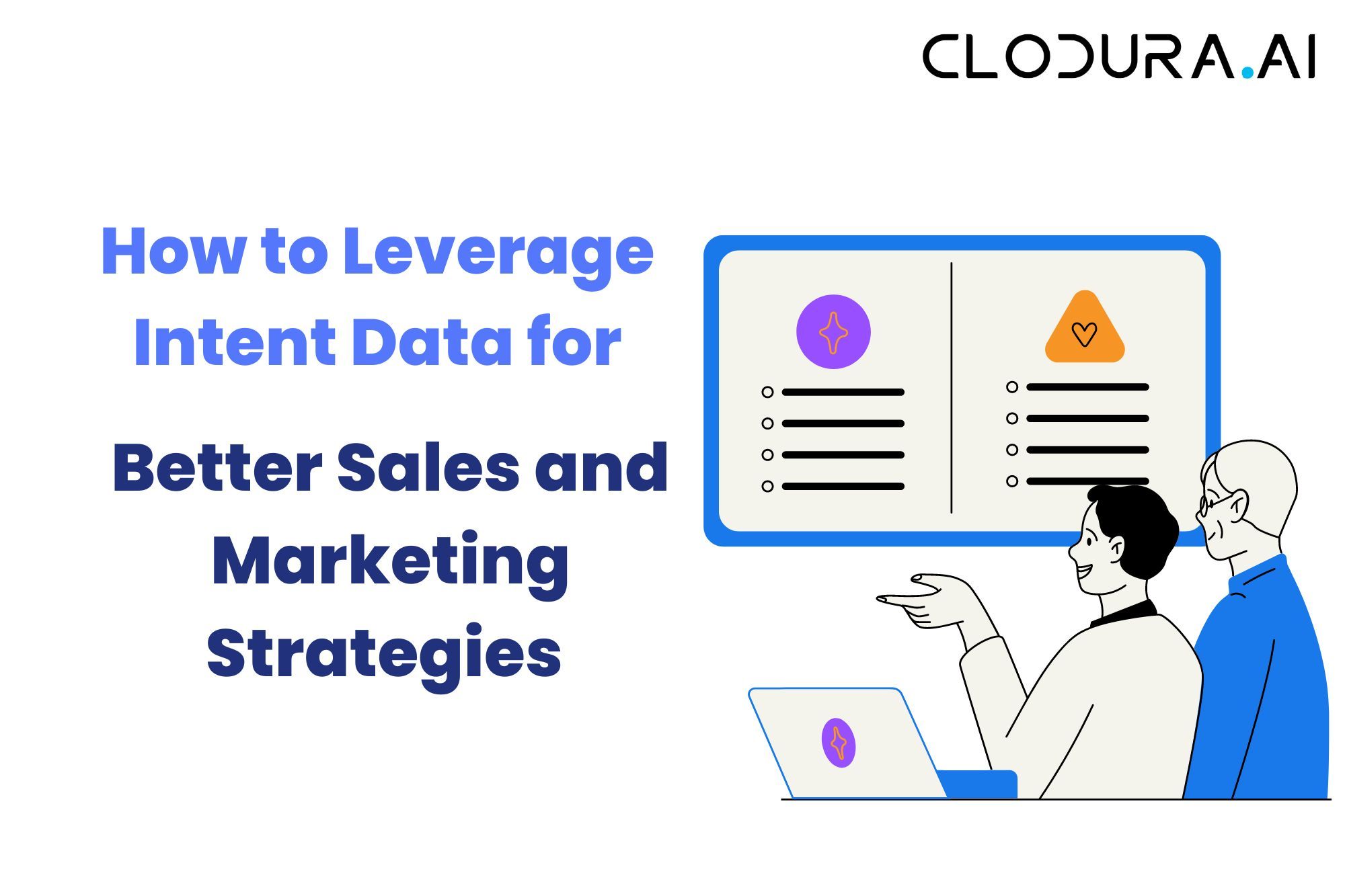In today's competitive business landscape, it's more critical than ever to harness every possible available tool to grow a business. One of the most powerful weapons that a marketer or salesperson can use is intent data. This data can offer invaluable insights into a customer's behavior and allow for a more targeted and effective approach.
In this blog, we'll discuss how to leverage intent data for better sales and marketing strategies.
Understanding the Importance of Intent in Sales and Marketing
Before we dive deeper into intent data, it's essential to understand why it's so crucial for sales and marketing efforts. Intent refers to the behavioral indicators that suggest a customer is ready to make a purchase. These indicators could be anything from a search query on Google to a specific action on a website.
When it comes to sales and marketing, understanding a customer's intent can make all the difference. By identifying the signals that suggest a customer is ready to buy, businesses can tailor their approach to meet the customer's needs precisely. This targeted approach can lead to a more effective sales and marketing strategy that reaches customers when they're most likely to convert.
“In this video, Codura.AI's CEO Kapil Khangaonkar discusses strategies for understanding the buyer's motive”
One of the most significant advantages of using intent data is that it allows businesses to gain insights into their customers' behavior. By analyzing the data, businesses can identify patterns and trends that provide valuable information about their customers' needs and preferences. Armed with this information, businesses can create targeted marketing campaigns that speak directly to their customers' interests.
Another benefit of using intent data is that it can help businesses identify potential customers who may not have engaged with their brand yet. By monitoring search queries and website activity, businesses can identify individuals who are showing interest in products or services that they offer. This information can then be used to create targeted marketing campaigns that reach these potential customers and encourage them to engage with the brand.
Overall, understanding the importance of intent in sales and marketing is critical for businesses looking to succeed in today's competitive marketplace. By leveraging intent data, businesses can gain valuable insights into their customers' behavior and create targeted marketing campaigns that speak directly to their customers' needs and interests.
So if you're looking to take your sales and marketing efforts to the next level, it's time to start paying attention to intent.
Types of Intent: Exploring Sales Intent and Marketing Intent
When it comes to understanding customer behavior, intent data is a powerful tool that can help businesses identify the right audience and tailor their messaging accordingly. Two types of intent data that are commonly used are sales intent and marketing intent.
● Sales Intent Data
Sales intent data is all about identifying when a customer is ready to make a purchase. This type of data is particularly useful for businesses that want to focus their efforts on high-value leads or accounts. By analyzing customer behavior, such as website visits, content downloads, and social media activity, businesses can identify which customers are most likely to make a purchase and when they are most likely to do so.
For example, a customer who has visited a business's pricing page multiple times in the past week may be showing strong sales intent. By reaching out to this customer with a targeted message or offer, the business can increase the likelihood of closing a sale.
● Marketing Intent Data
Marketing intent data, on the other hand, is focused on understanding a customer's browsing behavior and interests. This type of data is particularly useful for businesses that want to create targeted marketing campaigns that resonate with their audience. By analyzing customer behavior, such as website visits, content downloads, and social media activity, businesses can identify which topics or products are of interest to their audience.
For example, a customer who has downloaded multiple whitepapers on a particular topic may be showing strong marketing intent. By creating content or offers that are related to that topic, the business can increase the likelihood of engaging that customer and moving them closer to a purchase.

The Importance of Understanding Both Types of Intent Data
While sales intent and marketing intent data are different, they work together to offer a complete picture of a customer's behavior. By understanding both types of data, businesses can create more effective messaging and campaigns that are tailored to their audience's needs and interests.
For example, a business that sells software may use sales intent data to identify customers who are ready to make a purchase, and then use marketing intent data to create targeted content or offers that are related to the customer's specific interests or needs. This approach can help businesses increase their conversion rates and generate more revenue.
In conclusion, understanding the differences between sales intent and marketing intent data is crucial when it comes to leveraging them effectively. By using both types of data together, businesses can gain a deeper understanding of their audience and create more effective messaging and campaigns that resonate with their customers.
The Benefits of Using Intent Data in Sales and Marketing
The benefits of using intent data are numerous, starting with increased efficiency. By focusing their marketing efforts on customers who are more likely to buy, businesses can save time and money and see an immediate impact on their bottom line.
But what exactly is intent data? It refers to information that is gathered about a customer's behavior and activity online. This can include everything from search queries to website visits to social media engagement. By analyzing this data, businesses can gain insights into what their customers are interested in and what they are likely to purchase.
One of the key benefits of using intent data is that it allows businesses to be more targeted in their marketing efforts. Rather than casting a wide net and hoping to catch some customers, businesses can use intent data to identify those customers who are most likely to be interested in their products or services. This not only saves time and money, but it also leads to more effective marketing campaigns.
Moreover, intent data offers the opportunity to make more informed business decisions. By understanding what drives customer behavior, businesses can better tailor their products and messaging to their target audience, thereby reducing the risk of failure and boosting the chances of success.
For example, if a business is launching a new product, they can use intent data to identify which customers are most likely to be interested in that product. They can then tailor their messaging and marketing efforts to appeal to those customers, increasing the likelihood of a successful launch.
Overall, the benefits of using intent data in sales and marketing are clear. By leveraging this powerful tool, businesses can save time and money, make more informed decisions, and stay ahead of the competition.
Factors to Consider When Choosing an Intent Data Provider
If you're considering investing in an intent data provider, it's important to keep the following factors in mind to ensure you select the right one for your business:
1. Type of Data Collected:
Make sure the intent data provider you choose collects the type of data that is relevant to your business.
For example, if you're in the B2B space, you'll want to ensure that the provider focuses on collecting intent data from businesses rather than consumers.
2. Real-Time vs. Historical Data:
Consider whether you need real-time or historical data for your business. If you require up-to-the-minute insights, you'll need a provider that offers real-time data. On the other hand, if you're looking to analyze long-term trends, historical data may be more appropriate.
3. Accuracy of Analysis:
The level of accuracy in the provider's analysis is critical to ensure that you make informed business decisions. Look for a provider that uses advanced analytics tools and algorithms to analyze data and provide accurate insights.
4. Customer Support:
The level of customer support offered by the provider is also important. You'll want to ensure that the provider offers support when you need it and that you have access to a dedicated account manager who can help answer your questions.
5. Cost:
Finally, consider the cost of the provider. Determine your budget and ensure that the provider's pricing fits within it. Additionally, make sure you understand the provider's pricing structure and any additional fees associated with their services.
By keeping these factors in mind when selecting an intent data provider, you'll be able to choose the right one for your business needs and achieve better results from your marketing and sales efforts.
Best Practices for Using Intent Data to Boost Sales and Marketing Efforts
Intent data has the potential to revolutionize sales and marketing efforts, but businesses need to follow certain best practices to reap its benefits fully.
Here are some of the best practices for using intent data to boost sales and marketing efforts:
● Identify Relevant Keywords:
Businesses must identify relevant keywords that potential customers use when searching for products or services. This information helps create targeted content and targeted campaigns. This requires keyword research to identify high-value search terms, understand their intent, and develop content strategies that align with customers' needs.
● Determine the Customer's Journey:
Understanding the customer's journey is crucial for effective use of intent data. By understanding where a customer is in the journey, businesses can create targeted content and marketing campaigns that appeal to them. A customer journey map is a valuable tool to help businesses identify the different stages of the buying process.
● Focus on the Most Promising Leads:
Not all leads are created equal. Businesses should prioritize the leads that show the most promise based on intent data. By focusing on the most promising leads, sales and marketing teams can optimize their resources and achieve a higher return on investment.
● Analyze Data Regularly:
Intent data is dynamic and constantly changing. Businesses should regularly analyze this data to stay on top of changes in customer behavior and adjust their strategies accordingly. This allows businesses to stay ahead of the competition and maintain relevance in the marketplace.
● Integrate with Existing Systems:
Integrating intent data with existing systems, such as customer relationship management (CRM) tools, can help businesses streamline their sales and marketing efforts. It also allows businesses to create a more comprehensive view of their customers, which can help with personalized messaging and targeted campaigns.
● Use Personalization:
Personalization is essential for effective sales and marketing efforts. Using intent data to personalize messaging can help businesses build stronger relationships with potential customers and increase conversions. This involves tailoring content to meet the unique needs and interests of individual customers based on their search behavior and intent signals.

Overall, businesses that follow these best practices can effectively leverage intent data to boost sales and marketing efforts. By identifying relevant keywords, understanding the customer journey, focusing on promising leads, regularly analyzing data, integrating with existing systems, and using personalization, businesses can create a competitive edge and achieve higher ROI.
Real-Life Examples of Successful Sales and Marketing Campaigns Using Intent Data
Many businesses have achieved impressive results using intent data.
One example is AdRoll, which used intent data to identify high-value customers that they targeted with personalized ads and messaging. This approach resulted in a 65% increase in customer conversion and a 70% decrease in cost per acquisition.
Another successful example is HG Data, a B2B marketing intelligence company that used intent data to improve their account-based marketing strategy. By analyzing the intent data, they were able to identify key accounts that were actively researching their products and services. HG Data then focused their marketing efforts on these accounts, resulting in a 30% increase in lead-to-opportunity conversion and a 7x increase in the average deal size.
In another instance, a global technology company used intent data to identify prospects who were actively searching for solutions that their products could provide. They then customized their marketing messaging and sales outreach to these prospects, resulting in a 42% increase in sales pipeline and a 13% increase in revenue.
These real-life examples demonstrate how intent data can significantly improve sales and marketing efforts when used effectively. By identifying high-value customers, targeting key accounts, and customizing messaging, businesses can achieve impressive results and drive revenue growth.
Overcoming Challenges When Implementing Intent Data in Sales and Marketing Strategies
To overcome challenges, businesses need to take these 5 specific steps-
Step 1- Educate stakeholders:
It's essential to educate all stakeholders about the benefits of intent data and how it can improve sales and marketing efforts. By demonstrating its value and success stories, businesses can help to gain buy-in from decision-makers.
Step 2- Involve all teams:
It's critical to involve all teams, including marketing, sales, and customer success, in the implementation of intent data. This collaboration ensures that everyone is aligned and working toward the same goals.
Step 3- Choose the right provider:
Choosing the right provider of intent data is crucial. The provider should align with the business's goals, provide accurate data, and offer the necessary support to integrate it into sales and marketing workflows.
Step 4- Integrate with existing workflows:
To make the implementation of intent data successful, it's crucial to integrate it into existing sales and marketing workflows. This integration ensures that the teams are using the data effectively and not duplicating efforts.
Step 5- Analyze regularly:
It's crucial to analyze intent data regularly to stay on top of changes in customer behavior and adjust strategies accordingly. This analysis can help businesses to identify areas of improvement and opportunities for growth.

By following these best practices, businesses can overcome the challenges of implementing intent data and leverage its benefits effectively.
Future Trends in the Use of Intent Data for Sales and Marketing
The use of intent data in sales and marketing is a rapidly evolving field, and the future looks promising. Advancements in technology, particularly in artificial intelligence, will likely lead to more detailed and accurate insights into customer behavior and interests.
This will allow businesses to create even more personalized and effective marketing and sales strategies.
Moreover, as more businesses embrace the use of intent data, there will be an increased focus on standardizing the collection and analysis of this data.
This could lead to the development of new tools and platforms specifically designed for intent data, making it easier for businesses to leverage its power.
Finding New Opportunities with Intent Data
One of the primary advantages of using intent data is the ability to identify new sales opportunities. By tracking customer behavior and interests, businesses can pinpoint prospects who may not have been on their radar before.
Intent data can also help businesses create more effective account-based marketing (ABM) campaigns. By focusing on high-value accounts, companies can increase their chances of closing deals and generating revenue.
In addition to identifying new sales opportunities, intent data can also help businesses optimize their sales and marketing efforts. By understanding which tactics are most effective at different stages of the customer journey, companies can refine their messaging and allocate resources more efficiently.
Another benefit of using intent data is the ability to monitor customer sentiment and identify potential issues early on. By tracking online conversations and social media activity, businesses can stay ahead of any negative feedback and address concerns before they become major problems.
Finally, integrating intent data into sales and marketing strategies can help businesses stay competitive in an ever-changing marketplace.
By leveraging the latest technology and insights, companies can adapt quickly to new trends and customer preferences, positioning themselves for long-term success.
Wrapping up, the future of intent data in sales and marketing is bright, and businesses that stay ahead of the curve and embrace this technology will be well-positioned to thrive in the coming years.
FAQs
Q. What is intent data, and why is it important for sales and marketing strategies?
Intent data refers to behavioral indicators that suggest a customer is ready to make a purchase, and it is important for sales and marketing strategies because it allows for a more targeted and effective approach that can lead to increased sales and revenue.
Q. What are the types of intent data used in sales and marketing?
The two types of intent data used in sales and marketing are sales intent data and marketing intent data.
Q. What is sales intent data, and how can it be used?
Sales intent data is all about identifying when a customer is ready to make a purchase. This type of data is particularly useful for businesses that want to focus their efforts on high-value leads or accounts.
Q. What is marketing intent data, and how can it be used?
Marketing intent data is focused on understanding a customer's browsing behavior and interests. This type of data is particularly useful for businesses that want to create targeted marketing campaigns that resonate with their audience.
Q. What are the benefits of using intent data in sales and marketing?
The benefits of using intent data in sales and marketing include increased efficiency, more targeted marketing efforts, the opportunity to make more informed business decisions, and the ability to identify potential customers who may not have engaged with the brand yet.

